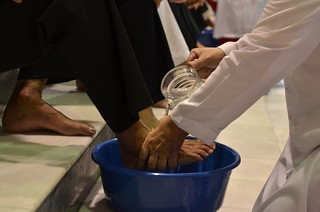| JOY Blog |
Pope Francis’ visit to the United States over six days in September 2015 made history. Not only was he the first pope to address a joint session of the U.S. Congress, he also made many strong statements on immigration, climate change, mercy and forgiveness.
Pope Francis is beloved by many; however, he continues to attract controversy with some of his words and actions.
During Holy Week in Rome, for example, the Pope washed the feet of 12 prison inmates; among them were two women. One of the women was a Serbian Muslim. Pope Francis performed this ritual as a sign of service and humility. Nevertheless, this simple act stirred the ire of many who follow strict Vatican law, which reserves such a ritual for 12 chosen men in order to replicate the act Jesus performed for His disciples during the Last Supper.
Regardless of which side people take, it is clear that this Pope is willing to risk judgment and criticism to perform an ancient tradition that expresses Jesus’ personal love and willingness to serve.
The story of the silent, nameless woman
Coincidentally, about the same time as Pope Francis’ visit to the U.S., I started a new Bible study on the book of Luke. I love this study, primarily because I have a wonderful teacher who motivates me to dig deeper. But I also I admire the book’s author. Luke is identified as a physician who presents an accurate, researched account of the life of Jesus as the perfect human and savior.
If you have ever read the Bible and sometimes feel women are under-represented, I challenge you to read Luke. It gives a prominent place to women, both named and nameless. These women are Bible legends. One of them, the woman who washed and anointed Jesus’ feet, goes without a name, but her story is powerful, significant and unforgettable.
Upon hearing about the Pope’s foot-washing controversy, I was reminded of this story in Luke 7:36-50. In this story, Jesus is invited to dine with a Pharisee named Simon. The Pharisees were known for their strict observance of religious laws and traditions, so this invitation gives them a chance to “check Jesus out.”
A woman in the town learns that Jesus will be at Simon’s house. She knows this is her opportunity to see Jesus. She arrives at the dinner, uninvited and with an alabaster jar of expensive perfume. When she realizes that no one was washing Jesus’ feet—as would be the custom—she stands behind the reclining Jesus and her tears begin to flow. She washes Jesus’ feet with her tears and uses her hair to dry them. She then kisses His feet and anoints them with the fragrant perfume. Through all this, she remains silent.
The Pharisee Simon observes this demonstration with great contempt, as he has judged the woman to be an uninvited sinner. He also cannot believe Jesus would have anything to do with a sinner and therefore could not be truly holy.
Knowing his thoughts, Jesus speaks.
“Then he turned toward the woman and said to Simon, “Do you see this woman? I came into your house. You did not give me water for my feet, but she wet my feet with her tears and wiped them with her hair. You did not give me a kiss, but this woman, from the time I entered, has not stopped kissing my feet. You did not put oil on my head, but she has poured perfume on my feet. Therefore I tell you, her many sins have been forgiven – for she loved me much. But he who has been forgiven little loves little.” Then Jesus said to her, “Your sins are forgiven.” (Luke 7: 44-48 NIV)
What we can learn about worship from the unnamed woman
How can you not admire this woman’s tenacity and determination to see Jesus? How can you not be amazed at the courage she musters to anoint His feet?
This woman’s actions toward Jesus teach us all something important about the act of worship. In “Wordless Worship of an Unnamed Woman,” Pastor Bob Deffinbaugh asks us to consider seven principles from the silent, nameless woman that pertain to worship.
-
Worship is for sinners. The nameless woman was identified as a sinner, but Jesus openly accepts her gestures as an act of worship and forgives her sins.
-
Worship takes place at the feet of Jesus. While Simon did not even anoint Jesus’ head with oil, the woman was comfortable only at Jesus’ feet. She did not feel worthy to do anything else. Likewise, we need to acknowledge His greatness and our unworthiness.
-
Worship is preoccupation with the person of Jesus Christ. The woman put aside her fears about what others thought of her and focused only on Jesus.
-
Worship is not concerned about receiving something from our Lord as much as giving something to Him. So many times our prayers are presented like a wish list to God. The woman’s worship was expressed by her giving to Jesus, not getting from Him.
-
Worship involves the emotions. We could use less intellect and more emotion in our worship, such as this woman exemplified by her tears. Remember, we are to love the Lord our God with all our soul, heart, mind and strength.
-
The worship of this woman was without one word. Luke does not record the woman speaking, but that the Lord spoke to her. Sometimes the best worship may be accomplished in silence.
-
Worship is not easily hindered. The woman was an uninvited guest who was scorned, but she would not be deterred. What excuse truly is good enough to keep us from worship?
In writing this, I keep hearing the words of the great folk hymn, “Jesu, Jesu, Fill Us With Your Love." I leave you with these lyrics: “Kneel at the feet of our friends / Silently washing their feet / This is the way we should live with you.”
Will the courageous example of this silent nameless woman’s simple act change the way you worship?
 Royann Bold has lived in North Dakota her whole life and is a prairie girl at heart. She and her husband are empty nesters, having seen their three sons take flight to three different states. She also recently retired from the 8 to 5 grind, and is awash in pursuing her interests of writing, reading, volunteering and lifelong learning. She thoroughly is enjoying her free time to participate in Bible and book studies. Read more articles by Royann.
Royann Bold has lived in North Dakota her whole life and is a prairie girl at heart. She and her husband are empty nesters, having seen their three sons take flight to three different states. She also recently retired from the 8 to 5 grind, and is awash in pursuing her interests of writing, reading, volunteering and lifelong learning. She thoroughly is enjoying her free time to participate in Bible and book studies. Read more articles by Royann.



